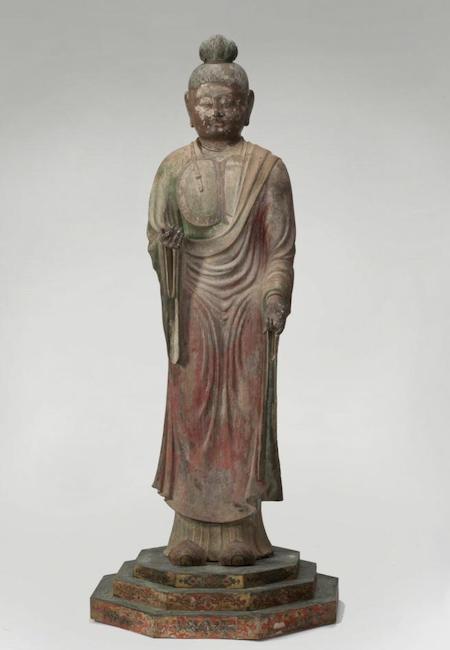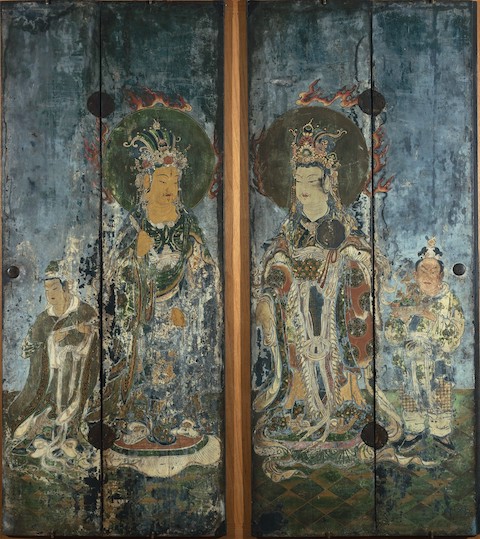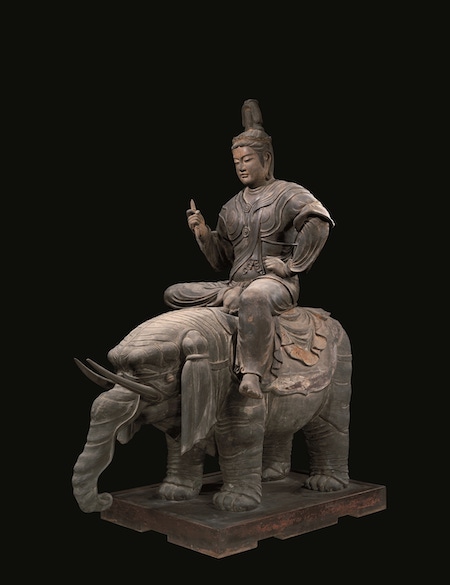
at Kōfuku-ji, now at the Asian Art Museum in San Francisco.
From asianart.org
Perhaps one of the more endearing qualities of Buddhism is its ability to syncretize with seemingly opposed ideologies. We see this in the Japanese concept of honji suijaku, where Indian (read: Buddhist) deities were given the forms of native Shintō kami to ease the conversion of the Japanese people. The transition was so effective that Japanese culture is now arguably inseparable from its Buddhist practices.
When Buddhism was still in its early development, many deities were adapted into its pantheon from Vedic and Hindu sources. These included Brahma (Jpn: Bonten), Kubera (also Vaisravana; Jpn: Bishamonten or Tamonten), and the various manifestations of Shiva (for example, Mahesvara). They were all grouped into the classification of celestial being(Skt: deva; Jpn: tenbu) as attendants to and protectors of the buddhas (Jpn: butsu) and bodhisattvas (Jpn: bosatsu) who dwell on the slopes and peak of Mount Sumeru (Jpn: Shumisen), the center of the Buddhist cosmos.
The fearsome Four Great Guardian Kings (Skt: caturmaharaja; Jpn: shitennō)—Vaisravana, Dhrtarastra (Jpn: Jikokuten), Virudhaka (Jpn: Zōchōten), and Virupaksa (Jpn: Kōmokuten)—are tasked with leading the defense of the celestial palaces. They answer to Shakra, the ruler of the celestial realm of innumerable devas Trayatrimsa (Jpn: Tōriten).
Shakra, abbreviated from “Shakra, king of the devas” (Skt: Sakro devanam indrah), originates from the Vedas as the king of the gods of the atmosphere. His name is an epithet of Indra, or the great Hindu god of war, storms, and rain, who was incorporated into the Buddhist pantheon as a guardian of the Law. As a powerful protector deity, Shakra dwells in the Palace of Correct Views (Skt: Vaijayanta; Jpn: Zenkenjō) at the center of his royal city Sudarsana, which lies on the slopes of Sumeru within the sensuous realm (Skt: kamadhatu; Jpn: yokukai).
According to the Flower Garland Sutra (Skt: Avatamsakasutra; Jpn: Kegonkyō), and especially in the teachings of the Chinese Huayan school, a gemmed net appears above Shakra’s palace. Called the Indrajala or Indra’s Net, this infinitely vast tool consists of an infinite number of knots, each of which contains a jewel with an infinite number of facets. Each facet reflects back the infinite other jewels and their reflecting facets. It serves as a metaphor for the interconnectedness and intercausality of the Buddhist universe.

attendants, 15th century. From harvardartmuseums.org
But perhaps Indra’s most pervasive contribution to Buddhist iconography is that of his diamond mace (Skt: vajra; Jpn: kongō), an indestructible and irresistible weapon of clarity and power. Indra, as god of the storms and likely derivative of the Greco-Roman Jupiter/Zeus, wields the lightning bolt. And as the lightning bolt falls from the celestial realm, the friction reduces it to a material not unlike the diamond. This diamond was then forged into a physical implement to be held by Shakra, his emanations, including Vajrapani (Jpn: Shūkongōshin), and numerous other deities.
In Buddhist art throughout East Asia, Shakra is subservient to the historical Buddha, Shakyamuni (Jpn: Shakamuni); he, with Brahma (Jpn: Bonten), guided the practice of Shakyamuni’s earlier incarnations and ministered to him in his final life before achieving buddhahood. In fact, the pair administered his first bath when he was a child. Especially in Indian Buddhist iconography, Shakra sometimes holds an umbrella over the historical Buddha to shield him from the Sun, or may also carry his alms bowl.
But even more than an attendant, Shakra serves as a vicious and immutable protector. He is occasionally depicted at the center of the Four Guardian Kings, both as their chief (Vaisravana leads them in Shakra’s absence) and as their superior to whom they report the activities of those in the lower realms of humans, asuras, animals, hungry ghosts, and hellish beings.

From tokyoweekender.com
Buddhist practitioners in Japan probably first acknowledged Shakra in the late seventh or early eighth century. There he was named Taishakuten and, though he was never the focus of an independent cult, he may appear with Bonten as attendants to a main icon in a triad. The most famous example of this is in the Never Empty Lasso Avalokiteshvara (Jpn: Fukūkenjaku Kannon) set in the Sangatsudō of Tōdai-ji; Taishakuten stands on Kannon’s left side. The triad dates to the Nara period (710–94). Taishakuten also appears as the principal image (Jpn: honzon) of the Shibamata Taishakuten, a temple in Katsushika, Tokyo. The temple was founded in 1629; it is likely this representation of Taishakuten was created specifically for this temple and has remained there to this day.
And though I have mentioned Tō-ji many times in past articles (it is a personal favorite, after all), the sculptural depiction of Taishakuten there is considered a Heian period (794–1185) masterpiece. The deity appears as a martial figure seated on an elephant with a single-pronged kongō in his right hand. The elephant, though more often associated in Japan with the bodhisattva Fugen (Skt: Samantabhadra), is an atavism to Erawan, the 33-headed elephant that served as Indra’s animal vehicle in earlier Indian art.
Taishakuten also appears among the jūniten, guardian deities adapted from Hinduism to protect the myriad buddhas and bodhisattvas in esoteric Buddhist practice, primarily in Japanese mandara (Skt: mandala) paintings.













